People who strive to eat healthy and monitor the food they eat know that nuts are one of the best sources of plant-based protein.
Whether eaten as a snack or a regular meal, nuts offer many benefits due to the different vitamins and minerals provided in a single serving of nuts. Nuts also contain antioxidants, which help in reducing free radicals that cause inflammation in our bodies.
There are many types of edible nuts that you can find all over the world. Some of them are processed into many commercial products or used widely as culinary ingredients. In this article, we have listed the top 21 types of edible nuts that you could consider adding to your health-conscious diet.
Table of Contents
1. Almonds
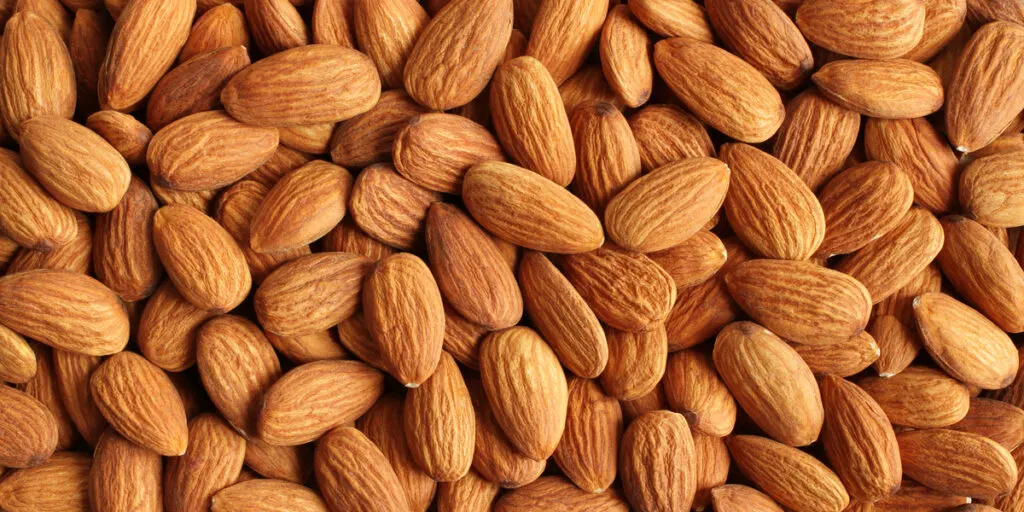
Almonds are the most popular type of nuts in the United States. These tree nuts come from almond trees that are native to the Mediterranean regions.
An almond is a seed. Almonds are covered with hard shells, which are discarded once the edible interior part is extracted.
Considered to be a healthy food, almonds contain protein, fiber, healthy fats, biotin, and other types of vitamins and minerals. They are also used to create many commercial products such as almond milk, flour, and even almond oil.
2. Pecan Nuts
Pecan nuts come from large deciduous trees that are native to the southern United States and northern Mexico. These nuts can be recognized by their hard, spotted shells and sweet, buttery taste.
To harvest pecan nuts, you will have to shake the tree to let the pecans fall or just wait until the pecans fall to the ground and pick them up.
Pecans are commonly used in appetizers and sweet foods. Aside from containing numerous vitamins and minerals, pecans are also high in calories and fat. These monosaturated fatty acids are beneficial for the heart.
3. Hazelnuts
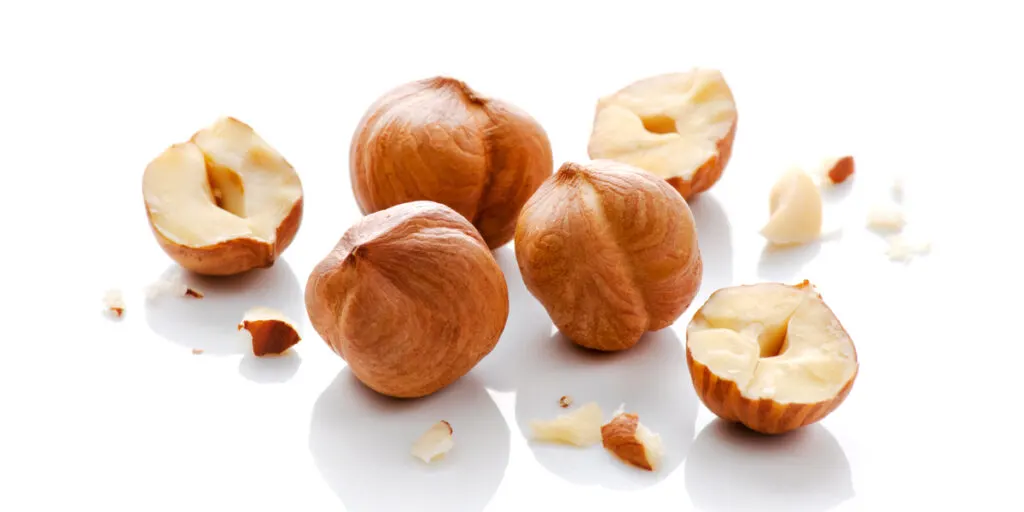
Hazelnuts are also known as filberts or cobnuts. They come from hazel trees that are native to western Asia and Europe. These nuts can be recognized by their small, round shape and kernels that have thick, dark brown skin.
If you have ever eaten bread or cookies with Nutella or Gianduja , you’ve eaten hazelnuts. These nuts are commercially processed and used to make those sweet chocolate spreads.
Hazelnuts are widely used to make Belgian praline, baking flour, and additional flavorings for desserts and snacks. They are also rich in protein, antioxidants, monosaturated fats, and other essential vitamins and minerals.
4. Cashew Nuts
Cashew nuts come from tropical evergreen trees that originated in Brazil. Today, cashew trees are commercially grown in many countries such as India, Indonesia, Nigeria, Ivory Coast, the Philippines, and Vietnam.
Although they are widely known as nuts, cashews are biologically categorized as seeds. Cashews can be recognized instantly by their kidney-shaped structure.
Cashews can be consumed as go-to snacks or processed into cashew milk. In some Chinese recipes, you can use cashews to make stir-frys and cashew chicken. Cashew nuts are also rich in many nutrients such as protein, fiber, healthy fat, magnesium, vitamin K and B6, iron, and other beneficial minerals.
5. Peanuts
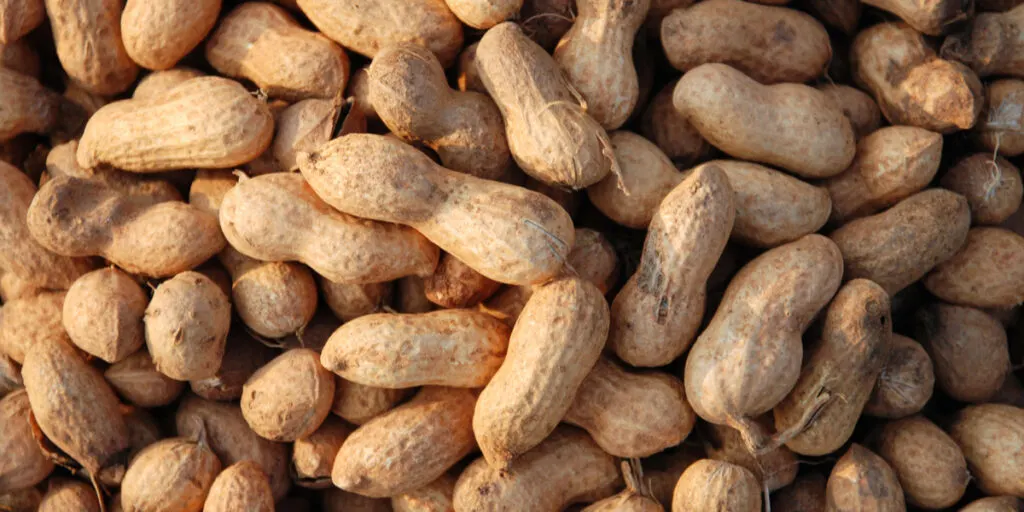
Also known as groundnuts, earth nuts, or monkey nuts, peanuts are the seeds of a plant that belongs to the botanical family, Fabaceae, which originated in South America. Peanuts are related to other legumes such as soy, lentils, and beans.
Peanuts are high in protein content and are used to make peanut butter, peanut oil, and baked products. Some people will also roast peanuts and eat them as snacks.
Although peanuts aren’t recognized as true nuts, they have the same nutritional content as walnuts and almonds. They are also a good source of biotin, which helps our bodies convert food into energy.
6. Walnuts
Walnuts are the wrinkly, round nut of the walnut tree, which originated in the Mediterranean regions. These tree nuts have green shells that will turn pale brown when they mature. Then, farmers and harvesters will collect the mature walnuts that fall on the ground.
Walnuts are considered high-calorie nuts due to the high ratio of fat to protein in their content. However, they are also full of antioxidants and omega-3 fats that are beneficial to our health.
Aside from being consumed as snacks, walnuts can also be used to make walnut oil and additional flavorings for baked products.
7. Macadamia Nuts

Macadamia nuts come from macadamia trees that originated from one single tree indigenous to Australia. Today, the world’s biggest macadamia producer is Hawaii, followed by South Africa.
These nuts can be recognized by their large, light brown shells and buttery taste. Generally, harvesters will collect these nuts from the ground before storing them in temperature-controlled spaces to prevent mildew.
Macadamia nuts are used in many products and baked goods including cookies, pies, chocolate, muffins, and granola. Macadamia nuts are even mixed into certain dishes.
8. Mongongo Nuts
Also known as manketti nuts or mongongo nuts, these nuts come from manketti trees that are native to the Kalahari desert in southern Africa. They can be recognized by their thick brown shells and light brown kernels.
Mongongo nuts are rich in different nutrients such as protein, calcium, and vitamin E. They can be eaten raw, roasted, or even steamed. Aside from their nutritious content, these nuts are also used to produce manketti oil, which helps in moisturizing and conditioning hair and nails.
9. Brazil Nuts
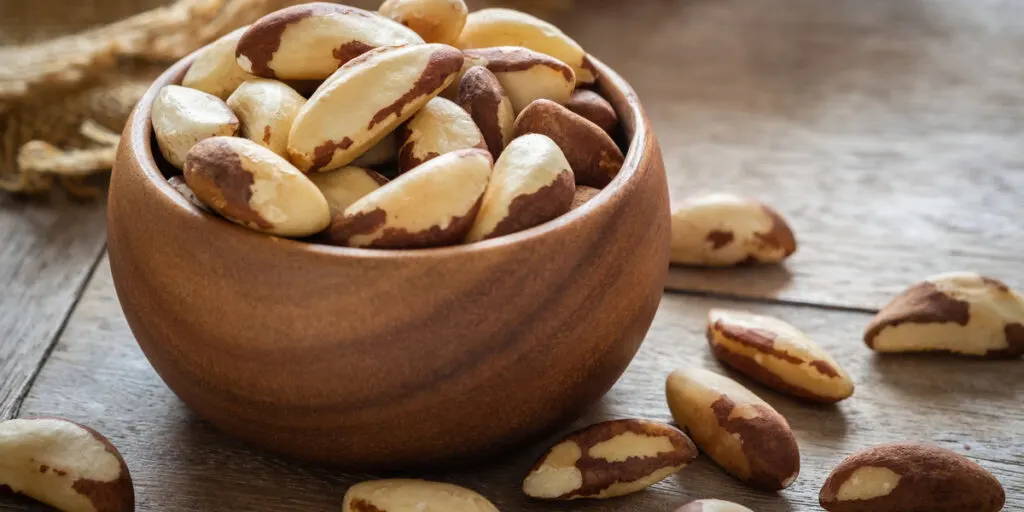
Brazil nuts are extracted from Bertholettia excelsa trees that are native to the Amazon rainforest, particularly in Brazil, Peru, and Bolivia. The tree produces pods that contain multiple Brazil nuts, and each Brazil nut is covered by a hard shell.
With their nutty and buttery taste, Brazil nuts can be consumed raw or blanched. They can be used to produce different foods including cookies, milk, and macaroons. Brazil nuts are also used as an accent in salads.
Brazil nuts are packed with nutrients, especially selenium, which is the most concentrated nutrient in the nut.
10. Pine Nuts
Pine nuts are the seeds of different species of pine trees, especially ones that originated in Europe, China, Italy, and the United States. These nuts are the smallest nuts on this list. Pine nuts can be distinguished by their ivory color, oily texture, and small size, measuring around half-inch long.
Pine nuts have a sweet and buttery flavor. They are usually consumed after they’re dried and toasted. These nuts are used to make pesto and mixed into many dishes. They can also be eaten as snacks or blended with dough and baking products to make cookies and cakes.
11. Chestnuts

Chestnuts are harvested from deciduous trees that are native to North America. There are four major species of chestnuts. They are American, European, Japanese, and Chinese chestnuts.
Chestnuts have a high concentration of starch. Hence, they are kept in a closed container after being harvested to allow for the conversion of those starches into sugar.
Although they can be eaten raw, chestnuts have a bland taste and are better served after they have been roasted. They can be mixed into many dishes or used in baked products.
12. Pistachios
Pistachios come from small trees that are members of the cashew family and originated in the Middle East and Central Asia. They are also grown in several parts of the United States, such as Arizona, New Mexico, and California.
Pistachios can be distinguished by their partly open brown shells and yellow or light green kernels. These nuts are high in protein, fat, fiber, antioxidants, and vitamin B6.
You can find pistachios in many popular desserts such as baklava, halvah, spumoni, kulfi, and ice cream. They can also be eaten raw or roasted to get the best taste out of them.
13. Kola Nuts
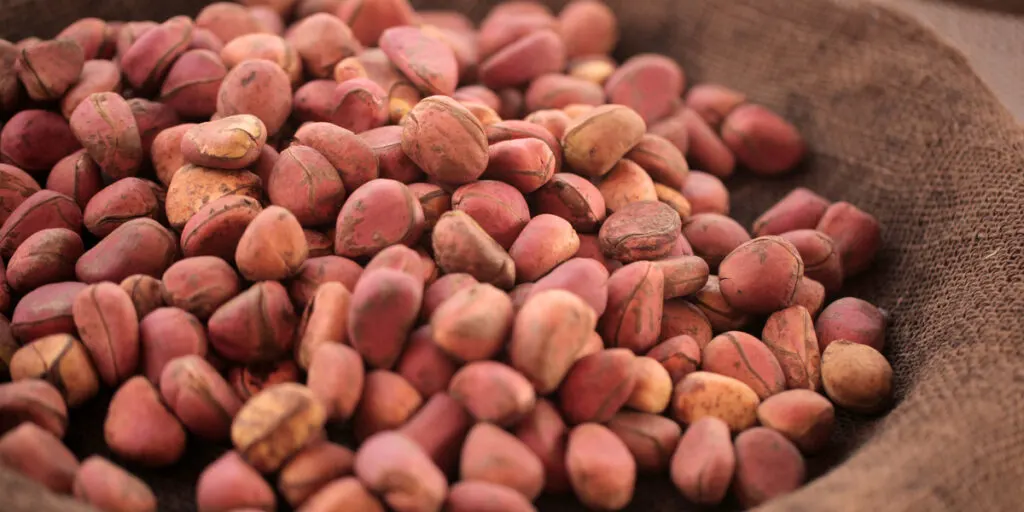
Kola nuts are harvested from kola trees, which are native to West Africa. These nuts are produced inside star-shaped fruits with white shells. They measure around two inches long with a white or reddish center.
Kola nuts have a bitter taste, so it isn’t advisable to eat them raw. However, when dried, kola nuts will release a nutmeg-like aroma. These nuts are also rich in caffeine and theobromine.
Kola nuts can also be ground into powder and used to facilitate digestion and bowel movement. They are also used as flavorings in certain drinks.
14. Butternuts
Also known as white walnuts, butternuts come from the trees of a walnut family that are native to the eastern United States and southern Canada. These nuts can be recognized by their football-like shape with greenish-brown husks. They also taste similar to pine nuts.
Butternuts are oily and can be eaten raw or processed into different products such as sauces, puddings, cookies, and bread.
Butternuts are also beneficial to our health. They are used for constipation, hemorrhoids, gallbladder and skin diseases, and for reducing the risk of hypertension.
15. Tiger Nuts
Tiger nuts come from the sedge grasses found mostly in Southern Europe, Africa, the Middle East, and the Indian subcontinent. They are also known as chufa, earth almond, or yellow nutsedge. There are three main varieties of tiger nuts: brown, black, and yellow.
Tiger nuts received their name from the tiger-striped texture that resembles both almond and coconut shells. Unlike other nuts, tiger nuts are actually tuberous rhizomes that are harvested from underground.
Tiger nuts can be eaten raw, boiled, roasted, or fried. These nuts can also be processed into tiger nut milk and tiger nut flour.
16. Hickory Nuts
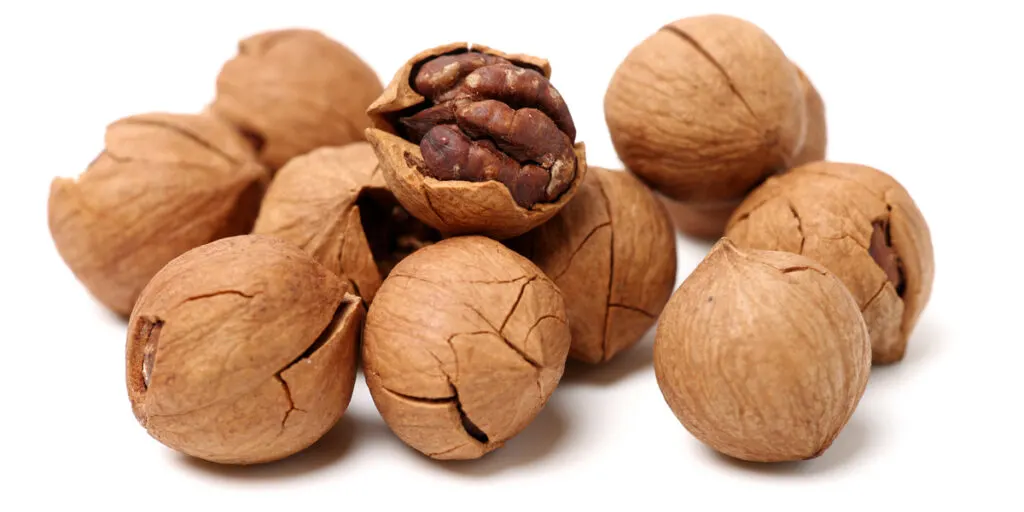
Hickory nuts are harvested from the trees of the genus Carya, which comprises 18 species that can be found in many countries such as China, India, Mexico, Canada, and the United States. Depending on the species, the nuts produced are different in size, color, and shape.
Hickory nuts have a high concentration of fat in their content. In fact, one ounce of hickory nuts yields around 193 calories.
Being a calorie-rich food, hickory nuts can be included in your diet as a source of healthy fat. They can be eaten raw or roasted and mixed with other foods. Hickory nuts can also be ground into powder before being processed into hickory milk.
17. Pili Nuts
Pronounced as “peeley,” these nuts come from tropical trees that originated in Southeast Asia, northern Australia, the Philippines, and Papua New Guinea. Most pili nuts that are sold commercially in the world mainly come from the trees in the Philippines.
Pili nuts can be recognized by unique, tear-shaped shells that turn to dark brown when ripe. These shells cover cream to light-brown kernels that taste similar to sunflower seeds when eaten raw.
Pili nuts can be roasted, salted, and added to baked goods or desserts. They are rich in many beneficial nutrients such as protein, magnesium, monosaturated fat, and phosphorus.
18. Baru Nuts

Baru nuts belong to the legume family and hail from the savannas of Brazil. Also known as Barukas nuts or chiquitanian almonds, these nuts are actually seeds with brown, oblong-shaped shells and a smooth interior. Baru nuts grow on the baruzeiro tree, and it takes the tree around seven to eight years to produce the nuts.
Baru nuts are considered a healthy superfood due to their high protein, carbohydrates, and fiber in their content with a low concentration of fat. They can be eaten raw as snacks, mixed with other food, or blended into a smoothie or juice.
19. Paradise Nuts
Also known as sapucaia, paradise nuts are harvested from lecythis trees that can be found in Brazil, Venezuela, Honduras, Ecuador, Guiana, and Suriname.
Paradise nuts can be recognized by their large, woody, gourd-like fruits that bear edible, white kernels. These fruits or shells are also called the “monkey pot” and grow as large as the size of a coconut.
Paradise nuts are rich in many nutrients, especially selenium and antioxidants. They can be roasted, fried, or processed into edible oils.
20. Marcona Almonds

Dubbed as the “queen of almonds,” these nuts hail from Spain and contain a higher fat content than California almonds. In fact, Marcona almonds are slightly different from California varieties. They can be distinguished by their large size and flat shape, and their flavor is sweeter, more buttery, and more earthy than other almonds.
Marcona almonds can be eaten raw, roasted, or fried with olive oil before being salted. They are also used in baked goods, served with cheese, or sprinkled over salads.
Marcona almonds are sold at a much higher price than other varieties. So, once you buy them, keep these nuts in a closed container to preserve their quality.
21. Saba Nuts
Saba nuts are also known as Malabar chestnuts, Guiana chestnuts, French chestnuts, Pumpo, or Monguba. These nuts are harvested from tropical trees in the willow family that is native to Central and South America.
Saba nuts can be recognized by their green, woody capsules or fruits that turn brown when mature and bear around 20 kernels that measure between three and four inches long. Saba nuts are white in color with a soft texture all over their shells.
Saba nuts can be eaten raw, roasted, boiled, fried, or mixed into other dishes.
Final Thoughts
Above all, nuts are one of the go-to snacks that you should have on hand. If you are a busy person and don’t have time to eat breakfast, then eat these nuts on your way to work. If you’re looking for healthy snacks that can give you enough energy before exercise, nuts would be your best option.
All of the edible nuts listed can be safely consumed. Of course, if you have a nut allergy, then try to avoid any types of nuts or products that contain nutty ingredients.
Citations
- https://blog.ediblearrangements.com/different-types-of-nuts/
- https://www.jessicagavin.com/types-of-nuts/
- https://www.homestratosphere.com/different-types-of-nuts/
- https://www.epicurious.com/ingredients/varieties-and-types-of-nuts-article
- https://www.masterclass.com/articles/types-of-edible-nuts
- https://www.wise-geek.com/what-are-some-different-kinds-of-edible-nuts.htm
